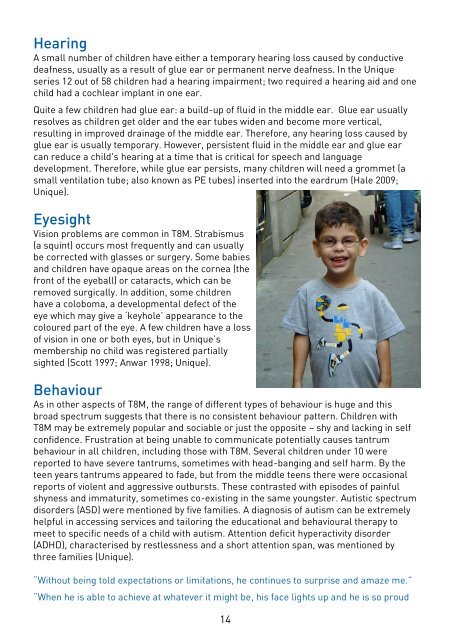Trisomy 8 Mosaicism - Unique - The Rare Chromosome Disorder ...
Trisomy 8 Mosaicism - Unique - The Rare Chromosome Disorder ...
Trisomy 8 Mosaicism - Unique - The Rare Chromosome Disorder ...
Create successful ePaper yourself
Turn your PDF publications into a flip-book with our unique Google optimized e-Paper software.
Hearing<br />
A small number of children have either a temporary hearing loss caused by conductive<br />
deafness, usually as a result of glue ear or permanent nerve deafness. In the <strong>Unique</strong><br />
series 12 out of 58 children had a hearing impairment; two required a hearing aid and one<br />
child had a cochlear implant in one ear.<br />
Quite a few children had glue ear: a build-up of fluid in the middle ear. Glue ear usually<br />
resolves as children get older and the ear tubes widen and become more vertical,<br />
resulting in improved drainage of the middle ear. <strong>The</strong>refore, any hearing loss caused by<br />
glue ear is usually temporary. However, persistent fluid in the middle ear and glue ear<br />
can reduce a child's hearing at a time that is critical for speech and language<br />
development. <strong>The</strong>refore, while glue ear persists, many children will need a grommet (a<br />
small ventilation tube; also known as PE tubes) inserted into the eardrum (Hale 2009;<br />
<strong>Unique</strong>).<br />
Eyesight<br />
Vision problems are common in T8M. Strabismus<br />
(a squint) occurs most frequently and can usually<br />
be corrected with glasses or surgery. Some babies<br />
and children have opaque areas on the cornea (the<br />
front of the eyeball) or cataracts, which can be<br />
removed surgically. In addition, some children<br />
have a coloboma, a developmental defect of the<br />
eye which may give a ‘keyhole’ appearance to the<br />
coloured part of the eye. A few children have a loss<br />
of vision in one or both eyes, but in <strong>Unique</strong>’s<br />
membership no child was registered partially<br />
sighted (Scott 1997; Anwar 1998; <strong>Unique</strong>).<br />
Behaviour<br />
As in other aspects of T8M, the range of different types of behaviour is huge and this<br />
broad spectrum suggests that there is no consistent behaviour pattern. Children with<br />
T8M may be extremely popular and sociable or just the opposite – shy and lacking in self<br />
confidence. Frustration at being unable to communicate potentially causes tantrum<br />
behaviour in all children, including those with T8M. Several children under 10 were<br />
reported to have severe tantrums, sometimes with head-banging and self harm. By the<br />
teen years tantrums appeared to fade, but from the middle teens there were occasional<br />
reports of violent and aggressive outbursts. <strong>The</strong>se contrasted with episodes of painful<br />
shyness and immaturity, sometimes co-existing in the same youngster. Autistic spectrum<br />
disorders (ASD) were mentioned by five families. A diagnosis of autism can be extremely<br />
helpful in accessing services and tailoring the educational and behavioural therapy to<br />
meet to specific needs of a child with autism. Attention deficit hyperactivity disorder<br />
(ADHD), characterised by restlessness and a short attention span, was mentioned by<br />
three families (<strong>Unique</strong>).<br />
“Without being told expectations or limitations, he continues to surprise and amaze me.”<br />
“When he is able to achieve at whatever it might be, his face lights up and he is so proud<br />
14

















